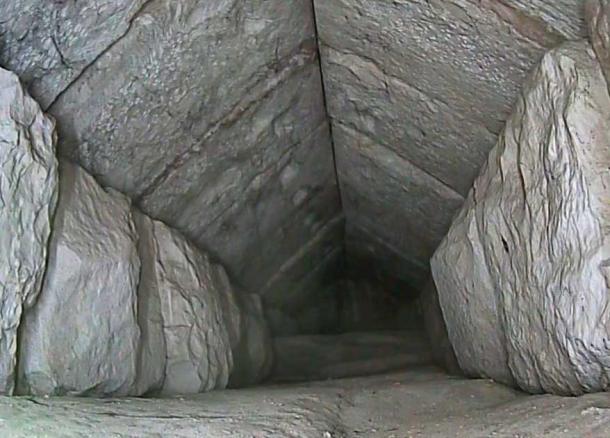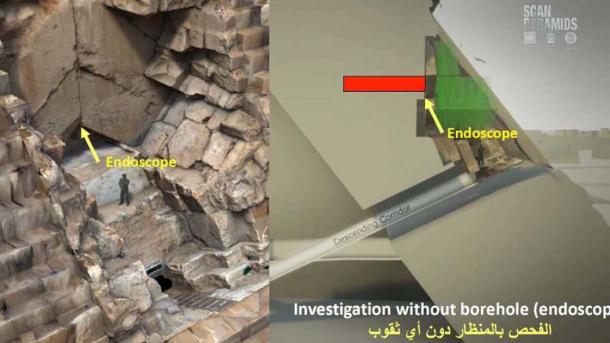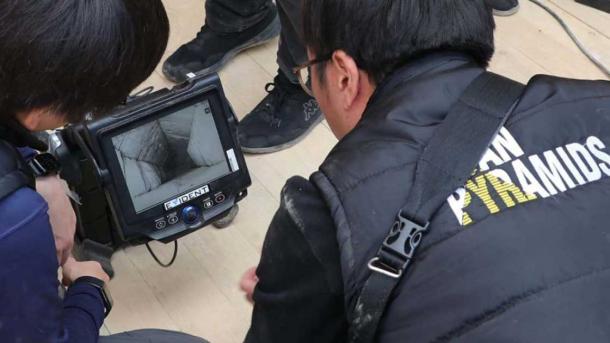Egyptologists have announced the discovery of a secret chamber located right above the main entrance to the Great Pyramid of Egypt. However, what it was created for is still a mystery.
On Thursday, Egypt’s Ministry for Culture and Tourism announced the existence of a newly discovered chamber on the northern side of the Pyramid of Khufu, “The Great Pyramid of Egypt,” on the Giza plateau outside Cairo.
In 2017, a team of scientists announced in a Nature report they had scanned another sealed-off chamber inside the Pyramid of Khufu , measuring 30-meters (98.43 ft). Now, the recently announced sealed-off room was identified directly above the main entrance to the Great Pyramid, and it measures 9 meters (29.52 ft) in length by 2 meters (6.56 ft) wide.

The endoscope image of the newly found chamber above the entrance of the Great Pyramid. ( MOTA)
Antiquity, Is No Hurdle For This Team
Great speculation surrounds the original purpose of this mesmeric structure known as the Great Pyramid, but mainstream archaeologists generally agree that it was built to be the tomb of Fourth Dynasty pharaoh, Khufu, who ruled in the early 26th century BC. Therefore, the recently identified enclosed space is probably around 4,500 years old.
The discovery was announced on Thursday by Zahi Hawass, the famous Egyptologist and former Minister of State for Antiquities, and Ahmed Eissa, Egypt’s current Minister for Tourism. The chamber was discovered during The Scan Pyramids Project, whose website boldly says, “Just because a mystery is 4500 years old doesn’t mean it can’t be solved…”.

Main entrance to Pyramid of Khufu, showing where the scan has revealed the chamber. (Scan Pyramids Project/ Ministry of Tourism and Antiquities )
The Team Who Discovered the Ancient Lost Chamber
Launched October 25, 2015, the The Scan Pyramids project is a highly esteemed scientific mission that comes under the authority of the Egyptian Ministry of Antiquities. However, it was initiated, designed and coordinated by the Faculty of Engineering of Cairo and the French HIP Institute (Heritage, Innovation and Preservation). And with help from scientists at the Université Laval of Quebec and Nagoya University of Japan a suite of advanced scanning technologies all came together to identify the secret room.
Christian Grosse, a Professor of Non-destructive Testing at the Technical University of Munich , and a leader of the project, told AP about several scanning methods that were applied to locate the chamber, for example, “ultrasound measurements and ground penetrating radars.” However, if you read The Scan Pyramids project website, it becomes apparent that an entire suite of advanced scanning technologies was applied.

Scan Pyramids researchers viewing what their hi-tech scanners have revealed. ( Ministry of Tourism and Antiquities )
Cosmic Ray Guns
Firstly, radiographic muons, or cosmic particles, are created when cosmic rays collide with the Earth’s upper atmosphere. “Muon Radiography” uses these particles to create 3D images of the interiors of large dense objects such as volcanoes, nuclear waste containers, and most recently, the Great Pyramid.
In addition to firing cosmic particles at the ancient structure, “infrared thermography” was applied, in which thermal cameras capture and create images based on infrared radiation emitted by the subject.
Furthermore, following the disciplines of “Photogrammetry” the team measured and interpreted photographic images and patterns of electromagnetic radiant imagery, and other phenomena. And what is perhaps most impressive, is that all of these scans were conducted with not a single rock having been touched at the famous Egyptian landmark.
The New Big Question
Grosse said his team of researchers identified “two large limestones at the end chamber.” Now, the new big question is “what’s behind these stones and below the chamber,” added Grosse.
While all of the aforementioned technologies have successfully revealed the presence of this mysterious lost chamber, what no robot can do is tell the researchers what the space was created for. Thus, the original purpose, or function, of the chamber, which cannot be accessed from outside, remains unknown.
However, in my opinion, its being located above the main entrance suggests it was designed to either reduce or enhance upward thrust, created by the entrance space. If so, this would be a very early example of a skill set that was used by the medieval European stonemasons who built the great cathedrals. They carefully designed ‘spaces,’ between the stones, to alter the upward thrust created by pointed arches and window spaces. So, I’ll call it, “an upward thrust alteration module”.
Top image: East-West cut view of the Great Pyramid and front view of the North face Chevron area. A) Subterranean chamber, b) queen’s chamber, c) grand gallery, d) king’s chamber, e) descending corridor, f) ascending corridor, g) al-Ma’mun corridor, h) north face Chevron area, i) ScanPyramids Big Void with horizontal hypothesis (red hatching) and inclined hypothesis (green hatching) as published in November 2017 . All these images were obtained from a 3D modelization using dedicated laser surveys and photogrammetry data. Source: Scan Pyramids/ Nature
By Ashley Cowie
 RSS Feed
RSS Feed















 March 3rd, 2023
March 3rd, 2023  Awake Goy
Awake Goy  Posted in
Posted in  Tags:
Tags: 













